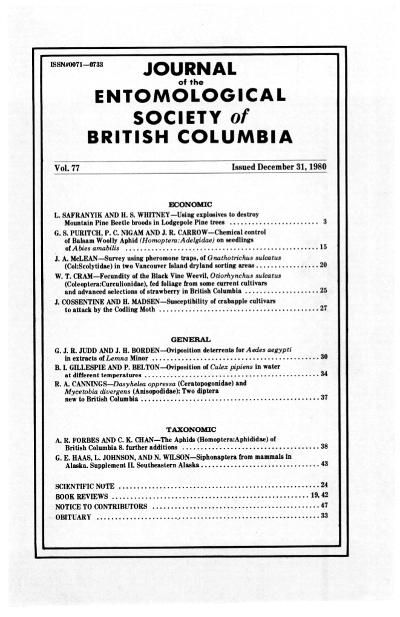Oviposition of <i>Culex pipiens</i> in water at different temperatures
Keywords:
<i>Culex pipiens</i>Abstract
At 20C air temperature, female <i>Culex pipiens</i> L. laid the greatest number of egg rafts at water temperatures between 20 and 25C. They laid very few at 15 or 35C even when given no alternative site. The possibility is discussed of manipulating temperature in a mosquito control programme.References
Angerilli, N.P.D. 1977. Some influences of aquatic plants on the development and survival of mosquito populations. Ph.D. Thesis. Simon Fraser University. 141 pp.
Bates, M. 1940. Oviposition experiments with Anopheline mosquitoes. Ann. J. trop. Med. 20:569-583.
Belton, P. 1967. The effect of illumination and pool brightness on oviposition by Culex restuans (Theo.) in the field. Mosq. News 27:66-68.
Fay, R.W. and D.A. Eliason. 1966. A preferred oviposition site as a surveillance method for Aedes aegypti. Mosq. News 26:531-535.
Gerberg, E.J., T.M. Hopkins, and J.W. Gentry. 1969. Mass rearing of Culex pipiens L. Mosq. News 29:382-385.
McLintock, J. 1960. Simplified method for maintaining Culex pipiens Linnaeus in the laboratory (Diptera: Culicidae). Mosq. News 20:27-29.
Smith, W.W. and D.W. Jones. 1972. Use of artificial pools for determining presence, abundance and oviposition preferences of Culex nigripalpus Theobald in the field. Mosq. News 32:244-245.
Wallis, R.C. 1954. A study of oviposition activity of mosquitoes. Ann. J. Hyg. 60:135-168.
Downloads
Published
Issue
Section
License
Authors who publish with the Journal of the Entomological Society of British Columbia agree to the following terms:
-Authors retain copyright and grant the journal right of first publication with the work simultaneously licensed under a Creative Commons Attribution License that allows others to share the work with an acknowledgement of the work's authorship and initial publication in this journal.
-Authors are able to enter into separate, additional contractual arrangements for the non-exclusive distribution of the journal's published version of the work (e.g., post it to an institutional repository or publish it in a book), with an acknowledgement of its initial publication in this journal.
-Authors are permitted and encouraged to post their work online (e.g., in institutional repositories or on their website) prior to and during the submission process, as it can lead to productive exchanges, as well as earlier and greater citation of published work (See The Effect of Open Access).


